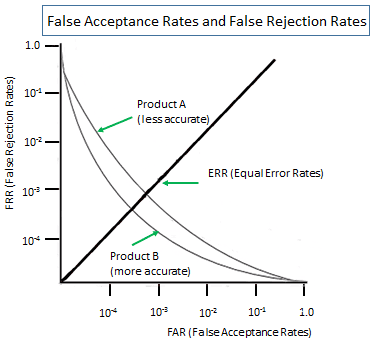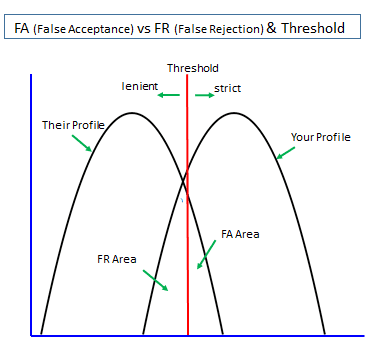Recent Development in Biometrics
Half year ago we felt a big shockwave to have heard a mind-boggling report of unnecessary deaths presumably brought by biometrics misunderstood from India where the biometrics; is mandatory for its Aadhaar-based Public Distribution System. There have since been intriguing new findings.
According to a report from India, actual False Acceptance Rates turned out to be 6% for fingerprints and 8.5% for iris scans in the large-scale use case of Aadhaar, which may look far higher than you have heard. And, a follow-up report says that a lock function has been introduced for the biometrics data.
By the way, the reports refer to ‘failure’ or ‘glitch’ of biometrics, but it is not necessarily correct. ‘False Rejection’ as against ‘False Acceptance’ is inherent in biometrics; there is no biometrics that is free from False Rejection. Let us explain this point closely.
A graph (*1) below shows the False Acceptance Rates (FAR) and False Rejection Rates (FRR) of two biometrics products – one relatively more accurate and the other less accurate.

What this graph indicates is, firstly, that FAR and FRR are not the variables that are independent from each other, but are dependent on each other.
A FAR could be fixed only against a certain FRR, i.e., both variables can be positioned only at the same single point on the same single curve. In other words, the couple of a FAR and a FRR can exist only in a certain combination.
Secondly, it also indicates that the lower a FAR is, the higher the corresponding FRR is. The lower a FRR, the higher the corresponding FAR. That is, FAR and FRR are not just mutually dependent but are in a trade-off relation
The level of a FAR that rejects a twin would have to bring the level of a FRR that rejects the registered user very frequently. The level of a FRR that eliminates the need of a fallback means would have to bring the level of a FAR that accepts nearly anyone.
Thirdly, also indicated is that the more accurate the biometrics sensor becomes (the lower the Equal Error Rate becomes), the curve goes downwards/leftwards in this graph. But, when a FAR is 0 (zero), the corresponding FRR still remains close to 1 (one). When a FRR is 0 (zero), the corresponding FAR remains close to 1 (one).
Another graph (*2) helps us to grasp how FAR and FRR are mutually dependent and also in a trade-off relation.

Move the threshold to the right (more strict) and we would see the combination of a lower FAR and a higher FRR. Moving it to the left (more lenient), the outcome would be the combination of a higher FAR and a lower FRR.
The presence of False Rejection, however close to 0 (zero) the rate might be, would require a fallback means against the False Rejection.
If the officials responsible for the Aadhaar-based PDS had been informed of the above, they must have provided a fallback means in case of the false rejection. Then this kind of misery could have been avoided. We have to wonder how it was possible that these people were not advised of the issue of false rejection.
The touted merits of biometrics were (a) security higher than passwords and (b) convenience better than passwords. We have been trying to demystify (a) and the actual case of Aadhaar and the like will hopefully be demystifying (b).
Thought Experiment in Two-Factor Authentication
A very strong passwords supposed to not be remembered and written down on a memo should be viewed as ‘what we have’, definitely not ‘what we remember’, so it could be used as one of the two factors along with a remembered password.
Although it may not be able to compete with a 2-factor scheme involving a PKI and OTP-based authenticator, a ‘boring legacy password system’ can be a two-factor authentication system made of ‘what we remember’ and ‘what we have’ just by verifying two passwords per access.
The merit of this plan is that the two-factor effects could be somehow achieved straightaway WITHOUT involving any costs of delivering and certifying the hardware tokens.
This kind of simple no-cost 2-factor schemes could have long been in broad use but it did not happen. We are wondering what prevented it from becoming popular. (Good security solutions come with a big price tag in many cases, so we might have taken it for granted that a solution coming with no big price tag cannot be a good solution. Was it?)
This could be viewed just as a thought experiment or could be considered for practical application between a single factor authentication and a costly heavily-armored 2-factor scheme.
What is needed in Brain-Machine-Interface
As for Man-Machine-Interface for EPS that accepts images in addition to characters, we already can rely on
– clicking and tapping on the images randomly positioned
– typing the characters randomly allocated to images
We will easily be able to rely on
– eye-tracking the images randomly positioned
– voice-recognizing the characters randomly allocated to images
– voiceless-voice-recognizing the same
– tapping secret signals on a pad when hearing the sounds that the users had registered (for the blind people)
– tapping signals when feeling the tactile sensation that the users had registered (for the blind & deaf people)
All the above can be achieved by deploying the off-the-shelf technologies. The next task is the interfaces for the people who cannot rely on any of the above. Here enters the possibility of BMI/BCI.
A simple brain-monitoring of the user’s eye-tracking has a problem in terms of security. The data, if wiretapped by criminals, can be replayed for impersonation straight away. Therefore the data should be randomized as the disposable onetime ones.
One idea is that the authentication system allocates random characters to the images. The users focus their attention on the characters given to the registered images. The monitoring system will collect the brain-generated onetime signal/data responding to these characters. If intercepting successfully, criminals would be unable to impersonate the users because the bugged data are onetime and disposable.
This article is part 2 in the series please click here to view part one
Other articles from this author.
https://www.paymentsjournal.com/confusion-still-persists-biometrics-passwords/
———————————————————————-
Internal Remarks;
In an earlier article
https://www.paymentsjournal.com/Mitigation-of-Password-Predicament/
OASIS Open Project
http://oasis-open-projects.org
Consumer Identity World 2018
https://www.kuppingercole.com/events/ciw2018
panel discussions
https://www.kuppingercole.com/speakers/1896
mind-boggling report
a report from India
A follow-up report









